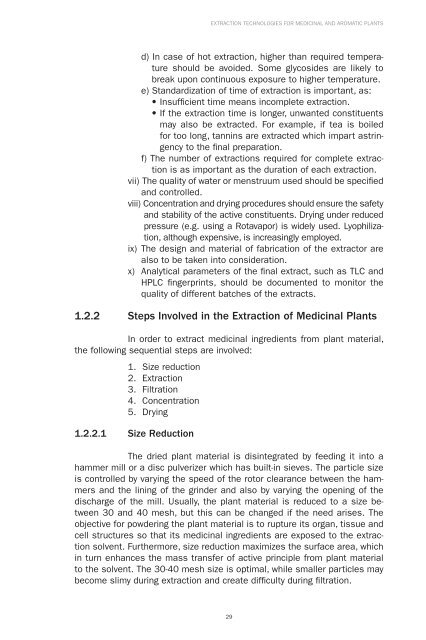Extraction Technologies For Medicinal And Aromatic Plants - Unido
Extraction Technologies For Medicinal And Aromatic Plants - Unido
Extraction Technologies For Medicinal And Aromatic Plants - Unido
Create successful ePaper yourself
Turn your PDF publications into a flip-book with our unique Google optimized e-Paper software.
EXTRACTION TECHNOLOGIES FOR MEDICINAL AND AROMATIC PLANTS<br />
d) In case of hot extraction, higher than required temperature<br />
should be avoided. Some glycosides are likely to<br />
break upon continuous exposure to higher temperature.<br />
e) Standardization of time of extraction is important, as:<br />
Insuffi cient time means incomplete extraction.<br />
If the extraction time is longer, unwanted constituents<br />
may also be extracted. <strong>For</strong> example, if tea is boiled<br />
for too long, tannins are extracted which impart astringency<br />
to the fi nal preparation.<br />
f) The number of extractions required for complete extraction<br />
is as important as the duration of each extraction.<br />
vii) The quality of water or menstruum used should be specifi ed<br />
and controlled.<br />
viii) Concentration and drying procedures should ensure the safety<br />
and stability of the active constituents. Drying under reduced<br />
pressure (e.g. using a Rotavapor) is widely used. Lyophilization,<br />
although expensive, is increasingly employed.<br />
ix) The design and material of fabrication of the extractor are<br />
also to be taken into consideration.<br />
x) Analytical parameters of the fi nal extract, such as TLC and<br />
HPLC fi ngerprints, should be documented to monitor the<br />
quality of different batches of the extracts.<br />
1.2.2 Steps Involved in the <strong>Extraction</strong> of <strong>Medicinal</strong> <strong>Plants</strong><br />
In order to extract medicinal ingredients from plant material,<br />
the following sequential steps are involved:<br />
1. Size reduction<br />
2. <strong>Extraction</strong><br />
3. Filtration<br />
4. Concentration<br />
5. Drying<br />
1.2.2.1 Size Reduction<br />
The dried plant material is disintegrated by feeding it into a<br />
hammer mill or a disc pulverizer which has built-in sieves. The particle size<br />
is controlled by varying the speed of the rotor clearance between the hammers<br />
and the lining of the grinder and also by varying the opening of the<br />
discharge of the mill. Usually, the plant material is reduced to a size between<br />
30 and 40 mesh, but this can be changed if the need arises. The<br />
objective for powdering the plant material is to rupture its organ, tissue and<br />
cell structures so that its medicinal ingredients are exposed to the extraction<br />
solvent. Furthermore, size reduction maximizes the surface area, which<br />
in turn enhances the mass transfer of active principle from plant material<br />
to the solvent. The 30-40 mesh size is optimal, while smaller particles may<br />
become slimy during extraction and create diffi culty during fi ltration.<br />
29

















